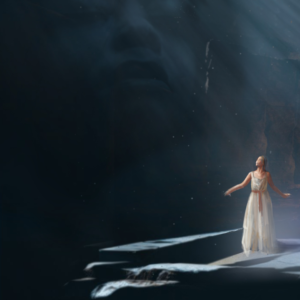Hycathae
Jump to
Recommended Pages
Hycathae are certain women who possess unique magical powers, originally believed to have been inherited from the goddess Hecate. Recent studies have discovered that these powers most likely arose due to a genetic mutation that has been passed down from mothers to daughters since 3500 BC. Hycathae are divided into three tiers: Baethlae, Cynthae and Nyridiae. Each tier has different strengths and abilities with Nyridiae being the most powerful. Hycathae adhere to the religion of Hycathism, also known as the Temple of Hycath.
Hycathism
Following the Sacking of the Vatican, Hycathism became one of Europe’s most widely spread religions. It is regulated by the several Oculi; groups of spiritual leaders with jurisdiction in the Hycathic community. These leaders are responsible for general council duties and inflicting punishments. They have representatives in every country, always led by a high priestess called the Octal. The worst punishment an Octal can inflict upon a Hycatha is a Reckoning, which means trapping the person and her powers into an object known as a Reckoning Hold.
Hycathism follows Hecate’s teachings based on eight pillars known as the essential aspects of an individual’s life: Care, Respect, Perception, Resilience, Ingenuity, Benevolence, Dedication and Competence. These pillars are documented and further examined in the Hycath Mythos, the most valued objects of the Hycathic community. The scriptures also contain the origin myth of the Hycathae and stories about Hecate’s travels to the underworld, believed to be the source of the first Nyridiae’s powers.
Powers
See also Hycath Powers
Contrary to popular belief, Hycathic “magic” would be better defined as a skill than sorcery. The women with Hycathic genes possess a deep and natural understanding of physics, and can manipulate particles on an atomic level. How well they can do that depends on which tier they belong to. Generally, Nyridiae are the most powerful Hycathae, followed by the Cynthae and then the Baethlae.
Transferral of Power
Hycathic powers are always passed from mothers to daughters. Unlike other kinds of inherited traits, these powers actually diminish in the mother as they are transferred, meaning that at the moment of birth the mother loses part of her own power.
Though Hycathic children possess their power from birth, the mechanics of using it are so complicated that they are not able to wield it without extensive training. This training is often carried out by their own mother when she deems the child mature enough. Women who miss the training will usually have difficulties controlling their powers, and they more easily exhaust themselves.
A strong Baethla can outperform an untrained Cyntha, so training is crucial for a Hycatha. If a Hycatha dies without a daughter, her magic will jump into the nearest object, which will become a Hycath Relic. These relics are powerful enough to be used by humans for magical purposes.
Tiers of Hycathae
Baethlae
Baethlae are the least powerful Hycathae. They can set items on fire, blow up small objects, speed up self-healing, shapeshift, breathe underwater and change the temperature on a small scale. They can’t perform any of these on a large scale, and they need lots of practice to perfect their skills and direct skin contact to perform them on another person or object.
Cynthae
Cyntha powers are similar to Baethla powers. However, Cynthae can extend their abilities to larger objects or tasks as long as they have direct skin contact. For example, they can shapeshift or breathe underwater for longer amounts of time and cause emotional impulses and make blood boil by touching someone’s skin.
Nyridiae
Nyridiae are the most powerful Hycathae, and due to that, their bloodlines have been monitored throughout history. Nyridiae possess the same skills as Baethlae and Cynthae with additional ones, but they don’t need skin contact to perform any of these. Nowadays, no Nyridiae line has survived; they only live on in Reckoning Holds like the Phoenix stones in the city of Al-Murooj.
Andrathae
Andrathae are humans of all genders who practise Hycathic magic without the inherited genetic mutation. The only way to do this is by using a Hycath Relic or a Reckoning Hold. Acquiring this skill demands plenty of training, sometimes achieved with the cooperation of Hycathae but often performed in isolation, so sacrilegious is the idea in Hycathism. This activity is extremely dangerous and often severely detrimental to the mental and physical health of the practitioner, as a normal human body cannot cope with these powers in the long term.
The Phoenix Stones
The Phoenix Stones are the most famous Reckoning Holds. Their origin goes back to the Second Hycath War (YE 752-755) when the infamous Blomgren sisters attempted world domination. They planned to destroy all humans and reinstate Hycathism as the ruling power. The sisters’ plan eventually failed when humans and Hycathae joined forces in order to stop them. By the end of the war, all the sisters were captured, sentenced and reckoned.
However, the three leading sisters, Ingeborg, Ragna and Ylva, were so powerful that the Oculus decided to create a specific prison that would still allow the rest of the world to benefit from their powers. This is how the three Phoenix Stones came to be. They would later play a significant role in creating the Hycathic safe haven of Al-Murooj, later known as The Promised Land. According to legend, the Red Phoenix Stone will protect and kill, whereas the Blue Stone can resurrect; the Green Stone will bring life to infertile land and sustain it, as well as sustaining life in those Fated Ones resurrected by the Blue Stone.
Reputation
Hycathae continue to have a complex and changeable reputation across the world, which fluctuates down the ages as a result of their direct involvement in many seminal and controversial historical events. Nevertheless, they can usually count on the allyship of Hycathi, humans of all genders who practise the religion of Hycathism but, unlike Andrathae, do not covet Hycathic magic.
For many centuries, Hycathae operated in largely clandestine groupings owing to religious persecution and suspicion levelled against them. Their advances were made in spaces they created, such as the pioneering Hycathic city-state of Aktau which, amongst other things, offered refuge and sanctuary to Hycathae driven from cities such as Constantinople.
Hycathae in Europe have seen their reputation change drastically over the centuries. The victory of Empress Matilda I in England’s First Hycath War began a campaign of overturning the religious and patriarchal oppression of the Catholic Church, which was eventually expelled from the continent in the wake of the Sacking of the Vatican. Hycathae led and shaped several of the societies that arose after these victories were achieved.
The aforementioned actions of the Blomgren sisters in instigating and losing the Second Hycath War caused a dramatic downturn in tolerance towards Hycathae in much of the world, explaining the consolidation of Al-Murooj as a modern refuge. This distrust has been exacerbated in particular on the Anglia Isle, where the war’s impact on climate change caused the Great Torrent and the Long Famine which followed it. The eventual culmination of all of this in the ill-fated Promised Land Campaign has sown further division. Placatory organisations such as East Mercia‘s Hycath Salvation Program have sprung up in response to this division, whilst anti-Hycathic pressure groups also exist. Despite this, the Isle and its countries still observe the Hycathic liturgical calendar and involve their Oculi in some ceremonial roles, though they do not have the political clout of ages past.


